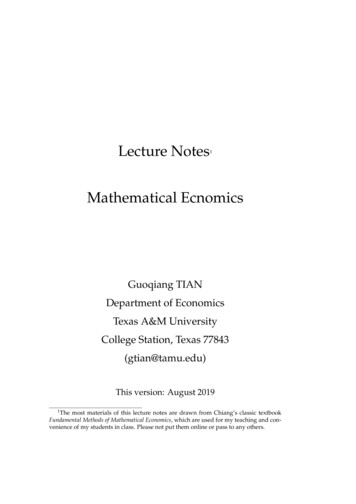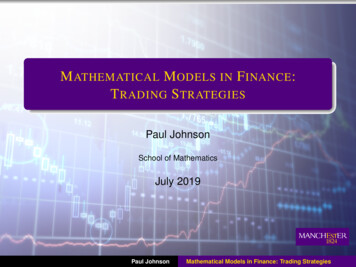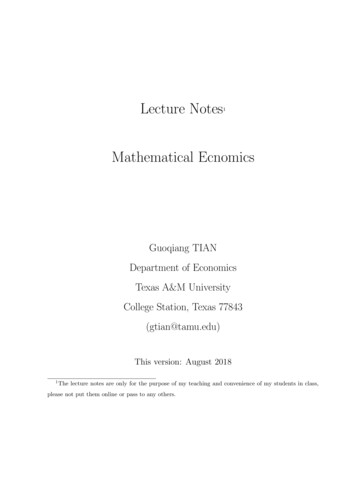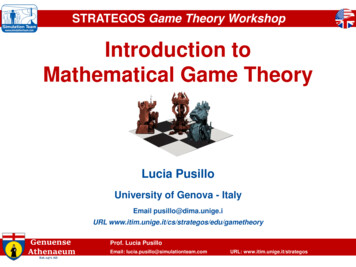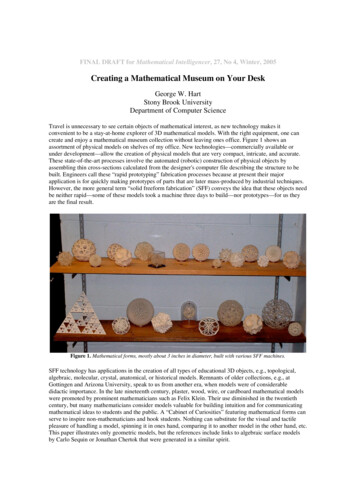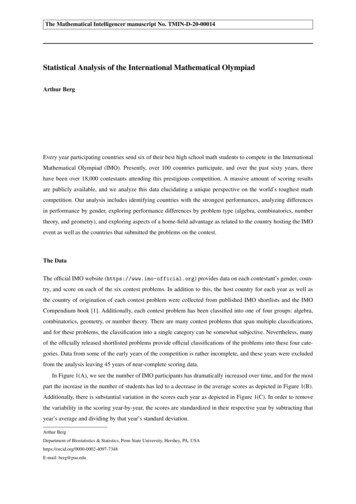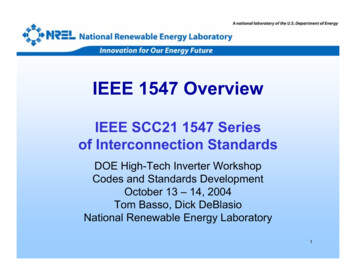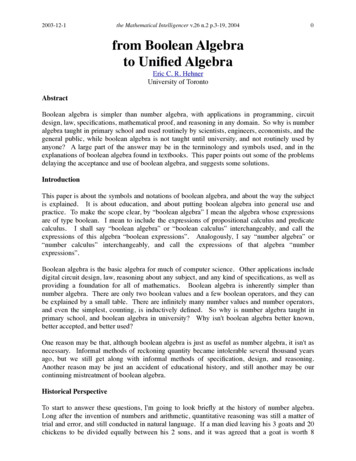
Transcription
2003-12-1the Mathematical Intelligencer v.26 n.2 p.3-19, 20040from Boolean Algebrato Uni ed AlgebraEric C. R. HehnerUniversity of TorontoAbstractBoolean algebra is simpler than number algebra, with applications in programming, circuitdesign, law, speci cations, mathematical proof, and reasoning in any domain. So why is numberalgebra taught in primary school and used routinely by scientists, engineers, economists, and thegeneral public, while boolean algebra is not taught until university, and not routinely used byanyone? A large part of the answer may be in the terminology and symbols used, and in theexplanations of boolean algebra found in textbooks. This paper points out some of the problemsdelaying the acceptance and use of boolean algebra, and suggests some solutions.IntroductionThis paper is about the symbols and notations of boolean algebra, and about the way the subjectis explained. It is about education, and about putting boolean algebra into general use andpractice. To make the scope clear, by “boolean algebra” I mean the algebra whose expressionsare of type boolean. I mean to include the expressions of propositional calculus and predicatecalculus. I shall say “boolean algebra” or “boolean calculus” interchangeably, and call theexpressions of this algebra “boolean expressions”. Analogously, I say “number algebra” or“number calculus” interchangeably, and call the expressions of that algebra “numberexpressions”.Boolean algebra is the basic algebra for much of computer science. Other applications includedigital circuit design, law, reasoning about any subject, and any kind of speci cations, as well asproviding a foundation for all of mathematics. Boolean algebra is inherently simpler thannumber algebra. There are only two boolean values and a few boolean operators, and they canbe explained by a small table. There are in nitely many number values and number operators,and even the simplest, counting, is inductively de ned. So why is number algebra taught inprimary school, and boolean algebra in university? Why isn't boolean algebra better known,better accepted, and better used?One reason may be that, although boolean algebra is just as useful as number algebra, it isn't asnecessary. Informal methods of reckoning quantity became intolerable several thousand yearsago, but we still get along with informal methods of speci cation, design, and reasoning.Another reason may be just an accident of educational history, and still another may be ourcontinuing mistreatment of boolean algebra.Historical PerspectivefififlfifififiTo start to answer these questions, I'm going to look brie y at the history of number algebra.Long after the invention of numbers and arithmetic, quantitative reasoning was still a matter oftrial and error, and still conducted in natural language. If a man died leaving his 3 goats and 20chickens to be divided equally between his 2 sons, and it was agreed that a goat is worth 8
2003-12-1from Boolean Algebra to Uni ed Algebra1chickens, the solution was determined by iterative approximations, probably using the goats andchickens themselves in the calculation. The arithmetic needed for veri cation was wellunderstood long before the algebra needed to nd a solution.The advent of algebra provided a more effective way of nding solutions to such problems, but itwas a dif cult step up in abstraction. The step from constants to variables is as large as the stepfrom chickens to numbers.In English 500 years ago, constants were called “nombersdenominate” [concrete numbers], and variables were called “nombers abstracte”. One of thesimplest, most general laws, sometimes called “substitution of equals for equals”,x y fx fyseems to have been discovered a little at a time. Here is one special case [20]:“In the firste there appeareth 2 nombers, that is 14x 15y equalle to one nomber, whiche is71y . But if you marke them well, you maie see one denomination, on bothe sides of theequation, which never ought to stand. Wherfore abating [subtracting] the lesser, that is 15yout of bothe the nombers, there will remain 14x 56y that is, by reduction, 1x 4y .Scholar. I see, you abate 15y from them bothe. And then are thei equalle still, seyng theiwer equalle before. According to the thirde common sentence, in the patthewaie: If you abateeven [equal] portions, from thynges that bee equalle, the partes that remain shall be equall also.Master. You doe well remember the firste grounds of this arte.”And then, a paragraph later, another special case:“If you adde equalle portions, to thynges that bee equalle, what so amounteth of them shall beequalle.”Each step in an abstract calculation was accompanied by a concrete justi cation. For example,we have the Commutative Law [0]:When the chekyns of two gentle menne are counted, we may count first the chekyns of thegentylman having fewer chekyns, and after the chekyns of the gentylman having the greaterportion. If the nomber of the greater portion be counted first, and then that of the lesserportion, the denomination so determined shall be the same.This version of the Commutative Law includes an unnecessary case analysis, and it has missed acase: when the two gentlemen have the same number of chickens, it does not say whether theorder matters. The Associative Law [0]:When thynges to be counted are divided in two partes, and lately are found moare thynges to becounted in the same generall quantitie, it matters not whether the thynges lately added becounted together with the lesser parte or with the greater parte, or that there are severalle partesand the thynges lately added be counted together with any one of them.As you can imagine, the distance from 2x 3 3x 2 to x 1 was likely to be several pages.The reason for all the discussion in between formulas was that algebra was not yet fully trusted.Algebra replaces meaning with symbol manipulation; the loss of meaning is not easy to accept.The author constantly had to reassure those readers who had not yet freed themselves fromthinking about the objects represented by numbers and variables. Those who were skilled in theart of informal reasoning about quantity were convinced that thinking about the objects helps tocalculate correctly, because that is how they did it. As with any technological advance, thosewho are most skilled in the old way are the most reluctant to see it replaced by the new.fifififififiToday, of course, we expect a quantitative calculation to be conducted entirely in algebra,without reference to thynges. Although we justify each step in a calculation by reference to analgebraic law, we do not have to justify the laws continually. We can go farther, faster, more
2003-12-1from Boolean Algebra to Uni ed Algebra2succinctly, and with much greater certainty. In a typical modern proof (see the rst Appendix)we see lines likeλrar (bab–1)r barb–1 arbr λrbr (λb)r (a–1ba)r a–1bra(a1–1b1)2 a1–1b1a1–1b1 a1–1(b1a1–1)b1 a1–1(µa1–1b1)b1 µa1–2b12(a1–1b1)r µ1 2 . (r–1)a1–rb1r µ1 2 . (r–1) µr(r–1)/2These lines were taken from a proof of Wedderburn's Theorem (a nite division ring is acommutative eld) in [15] (the text used when I studied algebra). Before we start to feel pleasedwith ourselves at the improvement, let me point out that there is another kind of calculation, aboolean calculation, occurring in the English text between the formulas. In the example proof[15] we nd the words “consequently”, “implying”, “there is/are”, “however”, “thus”, “hence”,“since”, “forces”, “if.then”, “in consequence of which”, “from which we get”, “whence”,“would imply”, “contrary to”, “so that”, “contradicting”; all these words suggest booleanoperators. We also nd bookkeeping sentences like “We rst remark .”, “We must now rule outthe case .”; these suggest the structure of a boolean expression. It will be quite a largeexpression, perhaps taking an entire page. If written in the usual unformatted fashion of proofsin current algebra texts, it will be quite unreadable. The same problem occurs with computerprograms, which can be thousands of pages long; to make them readable they must be carefullyformatted, with indentation to indicate structure. We will have to do likewise with proofs.A formal proof is a boolean calculation using boolean algebra; when we learn to use it well, itwill enable us to go farther, faster, more succinctly, and with much greater certainty. But there isa great resistance in the mathematical community to formal proof, especially from those who aremost expert at informal proof. They complain that formal proof loses meaning, replacing it withsymbol manipulation. The current state of boolean algebra, not as an object of study but as a toolfor use, is very much the same as number algebra was 5 centuries ago.Boolean CalculationGiven an expression, it is often useful to nd an equivalent but simpler expression. For example,in number algebrax (z 1) – y (z–1) – z (x–y)distribute (x z x 1) – (y z – y 1) – (z x – z y)unity and double negation x z x – y z y – z x z ysymmetry and associativity x y (x z – x z) (y z – y z)zero and identity x yfifififififififififiWe might sometimes want to nd an equivalent expression that isn't simpler; to remove thedirectionality I'll say “calculation” rather than “simpli cation”. We can use operators other than down the left side of the calculation; we can even use a mixture of operators, as long as thereis transitivity. For example, the calculation (for real x )x (x 2)distribute2 x 2 xadd and subtract 1 x2 2 x 1 – 1factor2 (x 1) – 1a square is nonnegative –1tells usx (x 2) –1
2003-12-1from Boolean Algebra to Uni ed Algebra3Boolean calculation is similar. For example,(a b) (b a)replace implications a b b a is symmetric a a b bexcluded middle, twice true true is idempotent trueAnd so (a b) (b a) has been simpli ed to true , which is to say it has been proven. Hereis another example. n· n n2 n3instance 0 02 03arithmetic trueAnd so ( n· n n2 n3) true , and so n· n n2 n3 is proven.Solving simultaneous equations can also be done as a boolean calculation. For example,x x y y 5 x – x y y 1subtract and add 2 x y in rst equation x – x y y 2 x y 5 x – x y y 1use second equation to simplify rst 1 2 x y 5 x – x y y 1 2 x y 4 x – x y y 1 x y 2 x – x y y 1use rst equation to simplify second x y 2 x – 2 y 1 x y 2 x y 3 x 1 y 2 x 2 y 1 x 1 y 2These examples show that simplifying, proving, and solving are all the same: they are all justcalculation.When an expression is too long to t on one line, it must be nicely formatted for easy reading,and when a hint is too long to t on the remainder of a line, it can be written on as many lines asit takes, but I do not consider formatting further here. One point worth mentioning is thatsubcalculations (if boolean, they are called subproofs or lemmas) can save copying unchangedparts of a calculation through many lines. These subcalculations can be done in another placeand referenced, or they can be done in-place, nicely formatted, to provide a structured calculation(structured proof). By far the best way to handle subcalculations is provided by windowinference systems [21] [2], which open a new window for each subcalculation, keep track of itssense (direction), and make its context available. For example, in solving the simultaneousequations, I used the second equation to simplify the rst, and then the rst to simplify thesecond.In this brief introduction to boolean calculation, I have not taken the time to present all the rules.For a complete presentation, the reader is referred to [14]. A research monograph that usescalculational proof is [7]. A textbook on discrete math that uses calculational proof is [10]. Forfurther discussion of calculational proofs see [9] [17].Traditional TerminologyfififififififififiFormal logic has developed a complicated terminology that its students are forced to learn.There are terms, which are said to have values. There are formulas, also known as propositionsor sentences, which are said not to have values, but instead to be true or false. Operators ( , –)
2003-12-1from Boolean Algebra to Uni ed Algebra4join terms, while connectives ( , ) join formulas. Some terms are boolean, and they have thevalue true or false , but that's different from being true or false. It is dif cult to nd ade nition of predicate, but it seems that a boolean term like x y stops being a boolean term andmysteriously starts being a predicate when we admit the possibility of using quanti ers ( , ).Does x y stop being a number term if we admit the possibility of using summation and product(Σ, Π)? There are at least three different equal signs: for terms, and and for formulasand predicates, with one of them carrying an implicit universal quanti cation. We can even nda peculiar mixture in some textbooks, such as the following:a b a a b bHere, a and b are boolean variables, is a boolean operator (disjunction), a b is a booleanterm (having value true or false ), a b a and a b b are formulas (so they are true orfalse), and nally is a logical connective.Fortunately, in the past few decades there has been a noticeable shift toward erasing thedistinction between being true or false and having the value true or false . It is a shift towardthe calculational style of proof. But we have a long way to go yet, as I nd whenever I ask mybeginning students to prove something of the form a b where is pronounced “exclusiveor”. They cannot even start because they expect something that looks grammatically like asentence. If I change it to either of the equivalent forms (a b ) true or a b they are happybecause they can read it as a sentence with a verb. But (a b ) true confuses them againbecause it seems to have too many verbs. If I ask them to prove something of the form a b ,they take an unwittingly constructivist interpretation, and suppose I want them to prove a orprove b because that is what “do a or b ” means in English. The same lack of understandingcan be found in many introductory programming texts where boolean expressions are not taughtin their generality but as comparisons because comparisons have verbs. We ndwhile ag true do something odbut not the equivalent, simpler, more ef cientwhile ag do something odbecause ag isn't the right part of speech to follow while . Our dependence on naturallanguage for the understanding of boolean expressions is a serious impediment.Traditional NotationsfifififififififififlflfiflfifiArithmetic notations are reasonably standard throughout the world. The expression738 45 783is recognized and understood by schoolchildren almost everywhere. But there are no standardboolean notations. Even the two boolean constants have no standard symbols. Symbols in useincludetrue tT10false fF01Quite often the boolean constants are written as 1 and 0 , with for disjunction, adjacency forconjunction, and perhaps – for negation. With this notation, here are some laws.x(y z) xy xzx yz (x y)(x z)x –x 1x(–x) 0The rst law above coincides with number algebra, but the next three clash with number algebra.The overwhelming reaction of algebraists to notational criticisms is: it doesn't matter whichsymbols are used; just introduce them, and get on with it. But to apply an algebra, one must
2003-12-1from Boolean Algebra to Uni ed Algebra5recognize the patterns, matching laws to the expression at hand. The laws have to be familiar. Ittakes an extra moment to think which algebra I am using as I apply a law. The logician R.L.Goodstein [8] chose to use 0 and 1 the other way around, which slows me down a little more.A big change, like using as a variable and x as an operator, would slow me down a lot. Ithink it matters even to algebraists because they too have to recognize patterns. To a largerpublic, the reuse of arithmetic symbols with different meanings is an insurmountable obstacle.And when we mix arithmetic and boolean operators in one expression, as we often do, it isimpossible to disambiguate.The most common notations for the two boolean constants found in programming languages andin programming textbooks seem to be true and false . I have two objections to these symbols.The rst is that they are English-based and clumsy. Number algebra could never have advancedto its present state if we had to write out words for numbers.seven three eight four ve seven eight threeis just too clumsy, and so istrue false true trueClumsiness may seem minor, but it can be the difference between success and failure in acalculus.My second, and more serious, objection is that the words true and false confuse the algebrawith an application. One of the primary applications of boolean algebra is to formalizereasoning, to determine the truth or falsity of some statements from the truth or falsity of others.In that application, we use one of the boolean constants to represent truth, and the other torepresent falsity. So for that application, it seems reasonable to call them true and false . Thealgebra arose from that application, and it is so much identi ed with it that many people cannotseparate them; they think the boolean values really are true and false . But of course booleanexpressions are useful for describing anything that comes in two kinds. We apply booleanalgebra to circuits in which there are two voltages. We sometimes say that there are 0s and 1s ina computer's memory, or that there are trues and falses. Of course that's nonsense; there areneither 0s and 1s nor trues and falses in there; there are low and high voltages. We needsymbols that can represent truth values and voltages equally well.Boolean expressions have other applications, and the notations we choose should be equallyappropriate for all of them. Computer programs are written to make computers work in somedesired way. Before writing a program, a programmer should know which ways are desirableand which are not. That divides computer behavior into two kinds, and we can use booleanexpressions to represent them. A boolean expression used this way is called a speci cation. Wecan specify anything, not just computer behavior, using boolean expressions. For example, ifyou would like to buy a table, then tables are of two kinds: those you nd desirable and arewilling to buy, and those you nd undesirable and are not willing to buy. So you can use aboolean expression as a table speci cation. Acceptable and unacceptable human behavior isspeci ed by laws, and boolean expressions have been proposed as a better way than legallanguage for writing laws [1]. They can be used to calculate the attractions and repulsionsamong a set of magnets.fififififififififiFor symbols that are independent of the application, I propose the lattice symbols and ,pronounced “top” and “bottom”. Since boolean algebra is the mother of all lattices, I think it isappropriate, not a misuse of those symbols. They can equally well be used for true and falsestatements, for high and low voltages (power and ground), for satisfactory and unsatisfactory
2003-12-1from Boolean Algebra to Uni ed Algebra6tables, for innocent and guilty behavior, or any other opposites.For disjunction, the symbol is fairly standard, coming from the Latin word “vel” for “or”.For conjunction, the symbol is less standard, the two most common choices being & and .We are even less settled on a symbol for implication. Symbols in use include The usual explanation says it means “if then”, followed by a discussion about the meaning of “ifthen”. Apparently, people nd it dif cult to understand an implication whose antecedent isfalse ; for example, “If my mother had been a man, I'd be the king of France.” [19]. Such animplication is called “counter-factual”. Some people are uneasy with the idea that false impliesanything, so some researchers in Arti cial Intelligence have proposed a new de nition ofimplication. The following truth table shows both the old and new de nitions.oldnewaba ba btrue truetruetruetrue falsefalsefalsefalse truetrueunknownfalse falsetrueunknownwhere unknown is a third boolean value. When the antecedent is false , the result of the newkind of implication is unknown . This is argued to be more intuitive. I believe this proposalbetrays a serious misunderstanding of logic. When someone makes a statement, they are sayingthat the statement is true. Even if the statement is “if a then b ” and a is known to be false,nonetheless we are being told that “if a then b ” is true. It is the consequent b that is unknown.And that is represented perfectly by the old implication: there are two rows in which a is falseand a b is true ; on one of these rows, b is true , and on the other b is false .Debate about implication has been going on for a long time; 22 centuries ago, Callimachus, thelibrarian at Alexandria, said “Even the crows on the roof croak about what implications aresound.”[3] [18]. In case you think that confusion is past, or just for beginners, consider theexplanation of implication in Contemporary Logic Design, 1994 [16]:“As an example, let's look at the following logic statement:IF the garage door is openAND the car is runningTHEN the car can be backed out of the garageIt states that the conditions — the garage is open and the car is running — must be truebefore the car can be backed out. If either or both are false, then the car cannot be backedout.”Even a Berkeley computer science and electrical engineering professor can get implicationwrong.fifififififiImplication is best presented as an ordering. If we are calling the boolean values “top” and“bottom”, we can say “lower than or equal to” for implication. It is easy, even for primaryschool students, to accept that is lower than or equal to , and that is lower than orequal to .With this new pronunciation and explanation, three other neglected booleanoperators become familiar and usable; they are “higher than or equal to”, “lower than”, and“higher than”. For lack of a name and symbol, the last two operators have been treated likeshameful secrets, and shunned. If we are still calling the boolean values “true” and “false”, thenwe shall have to call implication “falser than or equal to”. As we get into boolean expressions
2003-12-1from Boolean Algebra to Uni ed Algebra7that use other types, ordering remains a good explanation: x 4 is falser than or equal to x 6 , asa sampling of evaluations illustrates (try x 3, 5, 7). I have tried using the standard words“stronger” and “weaker”, saying x 4 is stronger than x 6 ; but I nd that some of my studentshave an ethical objection to saying that falsity is stronger than truth.That implication is the boolean ordering, with and at the extremes, is not appreciated byall who use boolean algebra. In the speci cation language Z [24], boolean expressions are usedas speci cations. Speci cation A re nes speci cation B if all behavior satisfying A alsosatis es B . Although increasing satisfaction is exactly the implication ordering, the designers ofZ de ned a different ordering for re nement where is not satis ed by all computations, onlyby terminating computations, and is satis ed by some computations, namely nonterminatingcomputations. They chose to embed a new lattice within boolean algebra, rather than to use thelattice that it provides.Implication has often been de ned as a “secondary” operator in terms of the “primary” operatorsnegation and disjunction:(a b) a bProofs about implications proceed by getting rid of them in favor of the more familiar negationand disjunction, as I did earlier in an example. This avoids the informal explanation, but itmakes an unsupportable distinction between “primary” and “secondary” operators, and hides thefact that it is an ordering. When we learn that implication is an ordering, proofs aboutimplications become shorter and easier.If we present implication as an ordering, as I prefer, then we face the problem of how to use thisordering in the formalization of natural language reasoning. To what extent does the algebraicoperator “lower than or equal to” correspond to the English word “implication”? Philosophersand linguists are welcome to consider this question. But we shouldn't let the complexities of thisapplication of boolean algebra complicate the algebra, any more than we let the complexities ofthe banking industry complicate the de nition of arithmetic.Symmetry and DualityIn choosing in x symbols, there is a simple principle that really helps our ability to calculate: weshould choose symmetric symbols for symmetric operators, and asymmetric symbols forasymmetric operators, and choose the reverse of an asymmetric symbol for the reverse operator.The bene t is that a lot of laws become visual: we can write an expression backwards and get anequivalent expression. For example, x y z is equivalent to z y x . By this principle, thearithmetic symbols are well chosen but – and are not. The boolean symbols are well chosen, but is not.flfififififififlfifififififififififiDuality can be put to use, just like symmetry, if we use vertically symmetric symbols for selfdual operators, and vertically asymmetric symbols for non-self-dual operators with the verticalreverse for their duals. The laws that become visual are: to negate an expression, turn it upsidedown. For example, ( – ) is the negation of ( – ) if you allow me to use thevertically symmetric symbol – for negation, which is self-dual. There are two points thatrequire attention when using this rule. One is that parentheses may need to be added to maintainthe precedence; but if we give dual operators the same precedence, there's no problem. Theother point is that variables cannot be ipped, so we negate them instead (since ipping isequivalent to negation). The well-known example is deMorgan's law: to negate a b , turn it
2003-12-1from Boolean Algebra to Uni ed Algebra8upside down and negate the variables to get –a –b . By this principle, the symbols – are well chosen, but are not. By choosing better symbols we can let thesymbols do some of the work of calculation, moving it to the level of visual processing.from Booleans to NumbersSome boolean expressions are laws: they have value no matter what values are assigned tothe variables. Some boolean expressions are unsatis able: they have value no matter whatvalues are assigned to the variables. The remaining boolean expressions are in between, and“solving” means nding an assignment of values for the variables for which the booleanexpression has value . (Solving is not just for equations but for any kind of booleanexpression.) A lot of mathematics is concerned with solving. And in particular, number algebrahas developed by the desire to solve. To caricature the development, we choose an unsatis ableboolean expression and say “What a pity that it has no solutions. Let's give it one.”. This hasresulted in an increasing sequence of domains, from naturals to integers to rationals to reals tocomplex numbers. The boolean expression x 1 0 is unsatis able in the natural numbers, butwe give it a solution and thereby invent the integers. Similarly we choose to give solutions tox 2 1 , x2 2 , x2 –1 , and thereby progress to larger domains. This progression is bothhistorical and pedagogical. At the same time as we gain solutions, we lose laws, since the lawsand unsatis able expressions are each other's negations. For example, when we gain a solutionto x2 2 , we lose the law x2 2 .As the domain of an operator or function grows, we do not change its symbol; addition is stilldenoted as we go from naturals to complex numbers. I will not argue whether the naturals area subset of the complex numbers or just isomorphic to a subset; for me the question has nomeaning. But I do argue that it is important to use the same notation for natural 1 and complex1 because they behave the same way, and for natural and complex because they behavethe same way on their common domain. To be more precise, all boolean expressions over thenaturals retain the same solutions over the complex numbers, and all laws of complex arithmeticthat can be interpreted over the naturals are laws of natural arithmetic. The reason we must usethe same symbols is so that we do not have to relearn all the solutions and laws as we enlarge orshrink the domain. And indeed, it is standard mathematical practice to use the same symbols.fifififififififififififlfiFor exactly the same good reasons that we have a uni ed treatment of number algebras, we mustnow unify boolean and number algebras. The question whether boolean is a different type fromnumber is no more relevant than the question whether natural and integer are different types.What's important is that solutions and laws are learned once, in a uni ed system, not twice incon icting systems. And that matters both to primary school students who must struggle to learnwhat will be useful to them, and to professional mathematicians who must solve and apply laws.Historically, number algebra did not grow from boolean algebra; but pedagogically it can do so.As already argued, the use of 0 1 for doesn't work. To nd an associationbetween booleans and numbers that works for uni cation, we must use a number systemextended with an in nite number. Such a system is useful for many purposes; for example, it isused in [13] to prove things about the execution time of programs (some execution times arein nite). For a list of axioms of this arithmetic, please see [13] [14]. The association that worksis as follows.
2003-12-1from Boolean Algebra to Uni ed Algebrabooleantop bottom negation conjunction disjunction implication equivalence exclusive or 9number in nity– minus in nity–negation minimum maximum order equality inequalityWith this association
2003-12-1 the Mathematical Intelligencer v.26 n.2 p.3-19, 2004 0 from Boolean Algebra to Unified Algebra Eric C. R. Hehner University of Toronto Abstract Boolean algebra is simpler than number algebra, with applications in programming, circuit design, law, specifications, mathemat


